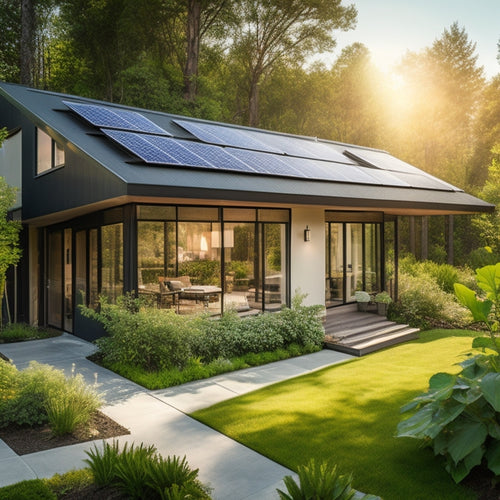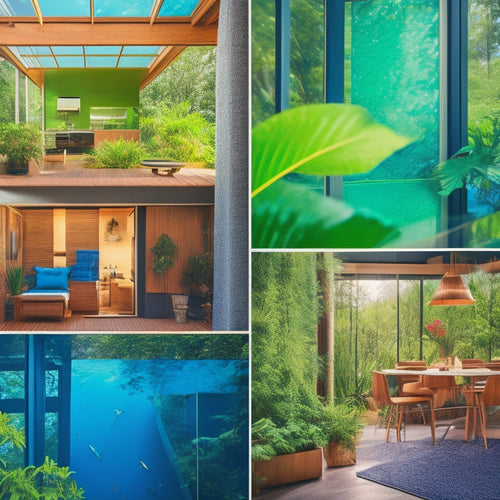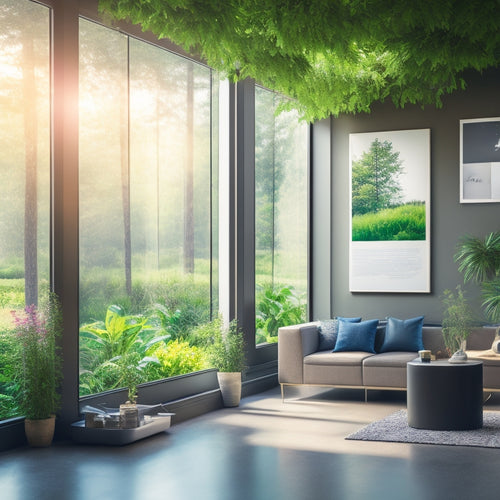Organizing for a Greener Tomorrow: Eco-Friendly Storage Solutions
Share
As you start to reorganize your space, you're likely thinking about more than just decluttering - you're considering the environmental impact of your storage solutions. You're not alone in wanting to reduce your carbon footprint. From the materials used in shelving units to the containers you choose for storing items, every decision counts. By making conscious choices, you can greatly minimize waste and promote sustainability. But where do you start? Let's explore the world of eco-friendly storage solutions together, and discover how you can create a more organized, environmentally responsible space that aligns with your values.
Key Takeaways
• Opt for eco-friendly materials like cardboard, bamboo, or reclaimed wood for sustainable storage solutions.
• Repurpose old containers and materials to reduce waste and foster creativity in storage solutions.
• Choose eco-friendly shelving options like reclaimed wood, bamboo, or recycled metal for a sustainable storage system.
• Incorporate upcycled furniture into your storage system to reduce waste and add unique style.
• Maximize storage space with minimal waste by using strategic layouts, compact designs, and multi-functional solutions.
Sustainable Storage Materials Matter
Your eco-friendly storage solutions start with the materials you choose, as sustainable storage materials can greatly reduce your carbon footprint. By opting for eco-friendly innovations, you'll not only minimize waste but also support a healthier environment.
Material transparency is crucial in making informed decisions. Look for certifications like FSC (Forest Stewardship Council) or PEFC (Programme for the Endorsement of Forest Certification) to guarantee the materials you choose come from responsibly managed forests.
When selecting storage materials, consider recycled or recyclable options like cardboard, bamboo, or reclaimed wood. These sustainable materials reduce the demand for virgin resources, decreasing deforestation and pollution.
Additionally, bioplastics, derived from renewable biomass sources, offer a more eco-friendly alternative to traditional plastics. As you make the switch to sustainable storage materials, remember that every small change adds up.
Repurposed Containers for a Cause
By repurposing containers, you can breathe new life into discarded items and divert them from landfills, simultaneously reducing waste and creating functional storage solutions that help the environment. This eco-friendly approach not only benefits the planet but also fosters creative reuses and community involvement.
Here are some innovative ways to repurpose containers:
-
Old pallets turned into shelves: Transform wooden pallets into unique shelving units that add a touch of rustic charm to your storage space.
-
Mason jars for desk organizers: Convert mason jars into quirky desk organizers for pens, pencils, and other office supplies.
-
Plastic bottle planters: Upcycle plastic bottles into mini planters for small plants or herbs, adding a touch of greenery to your space.
- Cardboard box storage crates: Reinvent cardboard boxes into sturdy storage crates for books, files, or other items.
Eco-Friendly Shelving Options Abound
As you explore eco-friendly shelving options, you'll find that reclaimed wood shelves offer a unique, sustainable solution. Not only do they reduce waste, but they also add a touch of character to your space.
Reclaimed Wood Shelves
One of the most striking eco-friendly shelving options is reclaimed wood shelves, which not only reduce waste but also add a touch of unique character to any room. By choosing reclaimed wood shelves, you're not only reducing the demand for newly harvested wood, but you're also giving new life to wood that would have otherwise been discarded.
Here are just a few benefits of incorporating reclaimed wood shelves into your space:
-
Rustic decor: Reclaimed wood shelves bring a touch of rustic charm to any room, adding warmth and coziness to your space.
-
Wooden accents: The natural imperfections of reclaimed wood add a unique character to your space, making it truly one-of-a-kind.
-
Earthy vibes: Reclaimed wood shelves bring a sense of natural, earthy elegance to your space, perfect for those who crave a connection to nature.
- Vintage charm: With their distressed finish and unique imperfections, reclaimed wood shelves evoke a sense of vintage charm, adding a touch of history to your space.
Sustainable Materials Matter
When it comes to eco-friendly storage solutions, you're spoiled for choice, with sustainable materials like bamboo, recycled metal, and low-VOC paints offering a wealth of environmentally responsible shelving options that not only reduce your carbon footprint but also elevate your space's aesthetic appeal.
Bamboo, in particular, boasts numerous benefits, including its rapid regeneration rate, low water requirements, and natural pest resistance. These advantages make bamboo an attractive option for eco-conscious consumers seeking sustainable storage solutions.
Recycled content is another key player in the sustainable materials arena. Recycled metal, for instance, reduces the need for primary materials, conserves natural resources, and decreases landfill waste. By choosing shelving units made from recycled metal, you're contributing to a more circular economy.
Furthermore, many recycled metal products are designed with durability in mind, ensuring your storage solutions stand the test of time. By embracing sustainable materials, you're not only doing your part for the environment but also investing in a more resilient, eco-friendly future.
The Power of Upcycled Furniture
You can transform discarded materials into functional pieces that not only reduce waste but also add a touch of uniqueness to your storage space with upcycled furniture. This creative reinvention of vintage items is a powerful way to reduce waste and add character to your space. Upcycled furniture isn't only eco-friendly but also a great way to showcase your personal style.
Here are some ways to incorporate upcycled furniture into your storage space:
-
Vintage Revival: Breathe new life into old pallets by transforming them into shelving units or coffee tables.
-
Creative Reinvention: Turn old crates into storage ottomans or side tables with a unique, rustic charm.
-
Eco-Chic Shelving: Use reclaimed wood to create one-of-a-kind shelving units that add a touch of sophistication to your space.
- Repurposed Decor: Transform old windows into decorative mirrors or room dividers that add a touch of vintage charm to your space.
Labels and Signs With a Twist
As you explore eco-friendly storage solutions, you're probably thinking about how to label and sign your organized spaces without harming the planet.
You'll be excited to learn that there are innovative, eco-conscious options available, from chalkboard labels that can be reused to clever, reusable signage ideas that reduce waste.
Let's take a closer look at these creative solutions that will elevate your storage game while keeping the environment in mind.
Chalkboard Label Options
Chalkboard label options offer a unique twist on storage organization by allowing you to easily update and reuse labels as your storage needs change. This modern take on traditional labeling is an eco-friendly solution that eliminates the need for paper labels, reducing waste. With chalkboard labels, you can effortlessly update your labels using a chalk marker, making it a convenient and sustainable option for your storage needs.
Here are some benefits of using chalkboard label options:
-
Easy to update: Simply erase and rewrite as needed.
-
Reusable: Reduce waste and minimize your environmental footprint.
-
Vintage charm: Add a touch of nostalgia with vintage-inspired designs.
- Compatible with label makers: Use your existing label maker to create custom chalkboard labels.
Reusable Signage Ideas
Reusable signage ideas take storage labeling to the next level by incorporating clever designs and materials that not only reduce waste but also add a touch of personality to your organizational system.
You can elevate your labeling game with reusable signs made from eco-friendly materials like recycled plastic, bamboo, or even fabric. These innovative signs can be reused multiple times, reducing the need for disposable labels and minimizing waste.
Take it a step further by incorporating digital displays into your labeling system. These high-tech signs can be easily updated and customized, making them perfect for inventory management and product labeling. Plus, they're a great way to add a modern touch to your storage space.
Add an extra layer of eco-friendliness with eco badges, which can be attached to your reusable signs or used as standalone labels. These badges are made from sustainable materials and can be customized with your logo or branding, making them a great way to showcase your commitment to the environment.
With reusable signage ideas, you can create a labeling system that's not only functional but also stylish and eco-friendly.
Eco-Chic Sign Designs
You can elevate your storage space's aesthetic appeal with eco-chic sign designs that combine functionality with visually striking elements, such as natural materials, bold typography, and vibrant colors. By incorporating nature-inspired elements, you can create a unique and visually appealing storage space that not only looks great but also promotes sustainability.
Here are some eco-chic sign design ideas to get you started:
-
Botanical Accents: Add a touch of nature to your signs with botanical accents like leaves, flowers, or branches.
-
Reclaimed Wood: Use reclaimed wood to create rustic, earthy signs that add warmth to your storage space.
-
Eco-Friendly Materials: Choose eco-friendly materials like bamboo, recycled paper, or bioplastics for a sustainable sign design.
- Nature-Inspired Typography: Incorporate nature-inspired typography, such as leaf-shaped letters or tree-bark textures, to add an organic feel to your signs.
Maximizing Space With Minimal Waste
By strategically designing your storage layout, you can optimize the use of available space while minimizing waste and reducing your environmental footprint. Compact living is all about making the most of your space, and it's vital for reducing waste. By maximizing your storage capacity, you'll decrease the need for unnecessary purchases and subsequent waste.
To achieve zero waste, you'll need to assess your current storage setup and identify areas for improvement. Start by decluttering and donating or repurposing items you no longer need. Then, reassess your storage layout to make sure it's functional and efficient.
Consider investing in multi-functional storage solutions, like shelves with built-in cabinets or storage beds. These space-saving solutions will help you make the most of your available space while reducing waste. By adopting a more mindful approach to storage, you'll be well on your way to a more sustainable, waste-free lifestyle.
Greening Your Closet Essentials
As you reassess your storage layout, it's time to turn your attention to the often-overlooked yet highly impactful area of closet essentials. A closet detox is long overdue, and it's time to swap out those old, wire hangers for eco-friendly alternatives.
Here are some simple swaps to get you started:
-
Ditch the wire hangers: Replace them with eco-friendly hangers made from sustainable materials like bamboo or recycled plastic.
-
Opt for cloth storage bins: Instead of using plastic bins, choose cloth storage bins that can be easily repurposed or recycled.
-
Use natural fiber organizers: Choose organizers made from natural fibers like cotton, hemp, or jute to add a touch of sustainability to your closet.
- Invest in a shoe rack made from reclaimed wood: Give new life to old wood and reduce waste with a beautifully crafted shoe rack.
Frequently Asked Questions
Can I Mix and Match Different Eco-Friendly Storage Materials?
You can mix and match different eco-friendly storage materials to achieve Material Harmony, but guarantee Sustainable Synergy by choosing complementary textures, colors, and durability to create a cohesive, high-impact storage system that amplifies your eco-friendly efforts.
Are Repurposed Containers Only for Decorative Purposes?
You're wondering if repurposed containers are only for decorative purposes? Not at all! You can discover creative reuses, transforming them into functional art that serves a purpose, like storing items while adding a touch of personality to your space.
What Is the Average Lifespan of Upcycled Furniture?
You can expect your upcycled furniture to last 10-15 years with a craftsman's touch, as sustainable art meets functionality, but this lifespan varies depending on materials, usage, and maintenance.
Can I Use Eco-Friendly Storage Solutions for Outdoor Spaces?
You can definitely use eco-friendly storage solutions for outdoor spaces, incorporating sustainable materials into your outdoor decor and yard organization, ensuring a seamless blend of style and environmental responsibility.
Are Eco-Friendly Storage Solutions More Expensive Than Traditional Options?
You'll find that eco-friendly storage solutions often cost more upfront, but their long-term benefits and reduced environmental impact make them a worthwhile investment, as you weigh cost comparison and prioritize the planet's future.
Related Posts
-

Integrating Solar Panels Into Home Design
Integrating solar panels into your home design greatly enhances energy efficiency and lowers utility bills while addi...
-

Innovative Sustainable Materials for Energy-Efficient Homes
Innovative sustainable materials enable you to create energy-efficient homes while promoting environmental responsibi...
-

High-Performance Energy-Efficient HVAC Systems
High-performance energy-efficient HVAC systems are essential for reducing energy consumption while improving indoor c...


